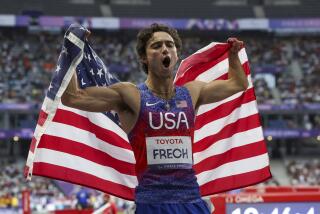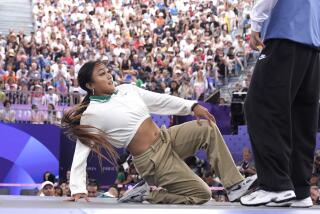Pan American Games : Small-Town Serenity Suits These Athletes : Santiago: Competitors in sports such as archery and softball have been impressed by the facilities and friendliness in this other host city.
SANTIAGO DE CUBA, Cuba — This is where the other Pan American Games are being held; the quiet, small-town friendly Games. Where Havana is busy and big, Santiago de Cuba is slow and small. While Havana is playing host to the “big-time sports,” Santiago is happily providing a home for such sports as archery and softball.
Situated on the southeastern tip of the island, Santiago could not be more removed from Havana, in both geography and outlook. The city of 346,000 is said to have a more Caribbean atmosphere--it is on the Caribbean side of Cuba--and the friendliness of the Santiagans has set the tone for the competition in the seven sports here: archery, softball, soccer, rhythmic gymnastics, artistic gymnastics, judo and weightlifting.
Havana has absorbed about 4,500 athletes, but there are only 820 competing here. Their experiences are likely to be entirely different from those of their peers in Havana.
Santiago is one of Cuba’s oldest cities, founded by the Spanish. Its colonial influence is found in the architecture--balconies with wrought-iron railings and many gracious plazas and squares.
It’s also a city steeped in history. The Moncada Barracks raid on July 26, 1953, led by a young lawyer named Fidel Castro, was a military failure but a political success and was one of the seminal events in the Cuban Revolution.
Castro was arrested, defended himself at his trial and made his famous “History Will Absolve Me” speech here. And it was in the jungles of the Sierra Maestra above Santiago where Castro hid while directing the uprising against Fulgencio Batista.
Teddy Roosevelt’s troops helped win the battle of San Juan a few miles out of town. Guantanamo Naval Base is to the east. Jose Marti, a national hero and the man considered to be the liberator of Latin America, is buried here.
In Santiago, American athletes think they have found an oasis.
“The facilities are great, the people are great,” said archer Denise Parker of South Jordan, Utah. “We keep hearing about problems in Havana and at the village there. We don’t have that here.”
The Games here are a self-contained unit, with little reliance on Havana for their operation. Local organizers have built two new facilities and refurbished others. The Multi-Purpose Hall, built for gymnastics, is modern and excellent, and the new softball stadium, called Micro 4, has drawn the praise of the players.
There was even an opening ceremony last Sunday, two days after Havana’s. However, in the ceremony something happened that could, at best, be called strange. As the various national delegations marched into the Guillermon Moncada Stadium, music associated with each country was played on the public address system. In some cases, the music was a national anthem. With other countries, characteristic music was played--such as reggae for Jamaica.
As the U.S. team entered the stadium, the music was not “The Star-Spangled Banner.” The band played “Dixie,” to the surprise of some Americans and the dismay of others.
“It struck us as an odd choice,” said Sheila Cornell, a softball player from Woodland Hills.
Organizing officials expressed surprise that “Dixie”--the anthem of the Confederacy and a song evocative of slavery--was such a controversial choice. Jorge Jose Oduardo Fernandez, director of Santiago’s sports office, said Wednesday he had consulted Cuban musicologists before selecting the song. The music of Michael Jackson and Donna Summer was also considered, he said.
Fernandez said no attempt was made to embarrass or offend Americans by choosing “Dixie.”
Most American athletes in Santiago said they were satisfied with the organization of the Games. Even being so far from the bulk of the competition in Havana, athletes here don’t feel out of touch.
“It would be nice to be with everyone else,” Cornell said. “But I don’t consider us as being with the Junior Pan Ams.”
It is possible that athletes in Santiago are taking the competition more seriously because, unlike the events in Havana, these teams represent the United States’ first string.
“I don’t think we feel out of it here because we are not in Havana,” said Tom Green, the U.S. archery team leader. “This is it, as far as we are concerned. This is our Pan Am Games.”
Absent from major sports and their pampered athletes, competitors claimed to be happier.
“We’re used to being left out,” Cornell said. “I kind of like it, away from some of the other sports. For instance, at Caracas (during the 1983 Pan American Games in Venezuela) the (U.S.) men’s basketball team took one look at the village and they all moved into a hotel. It’s nice not to be around that kind of stuff. We’re all in this together.”
Because they are so few, the U.S. athletes find themselves spending more time together than they would have if they had been part of the huge delegation in Havana. There are 199 in Santiago’s U.S. delegation, which includes coaches, medical staff and the U.S. media. Athletes account for about half that number.
“We’ve gone to other events, and we see the other athletes at the village,” said Suzy Brazney, a softball player from Fullerton. “We kind of stick together here. There are not many of us.”
More to Read
Go beyond the scoreboard
Get the latest on L.A.'s teams in the daily Sports Report newsletter.
You may occasionally receive promotional content from the Los Angeles Times.







